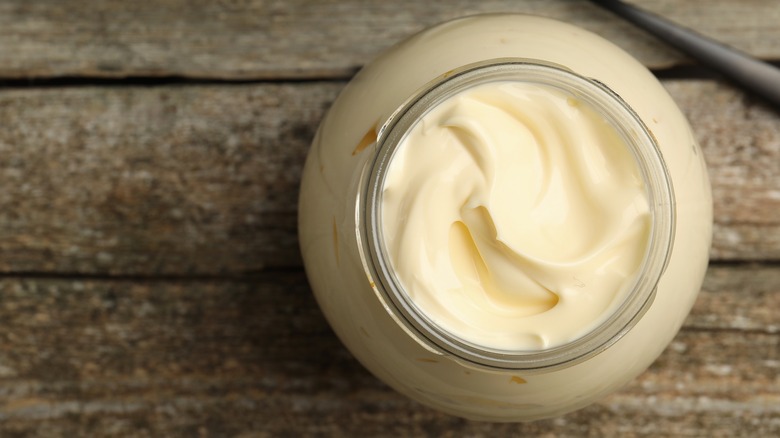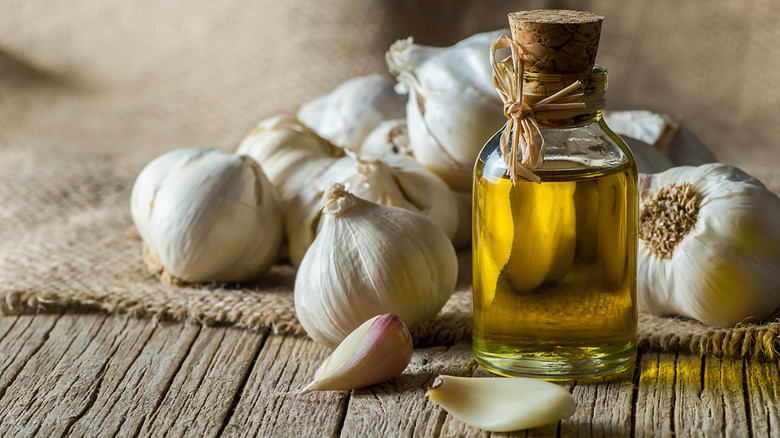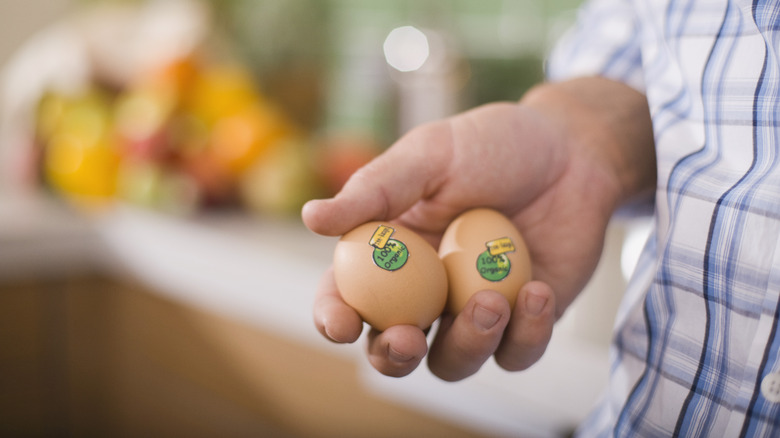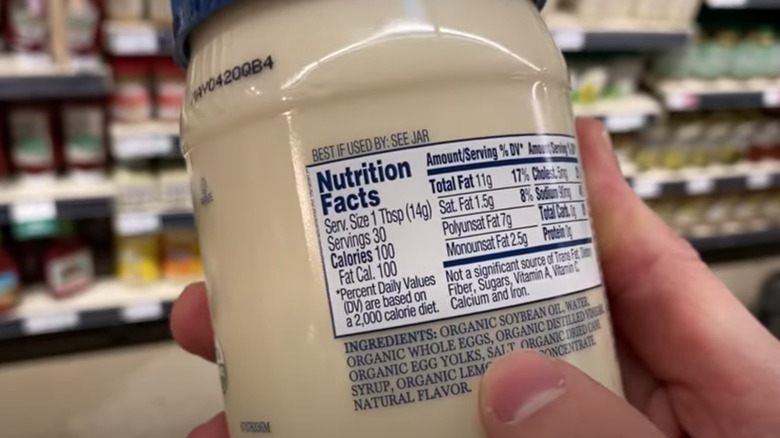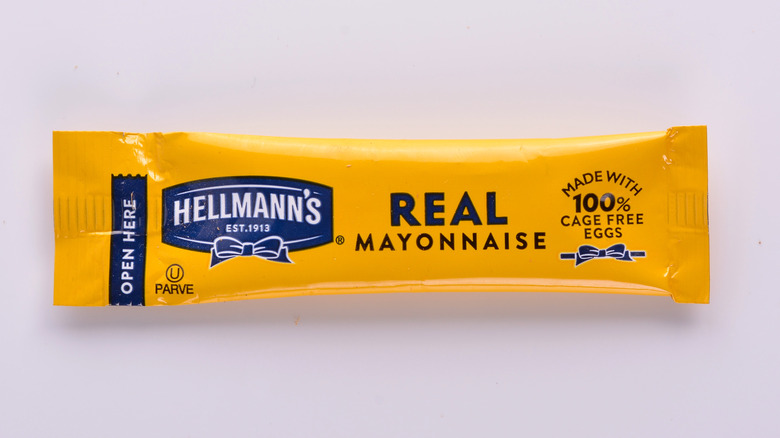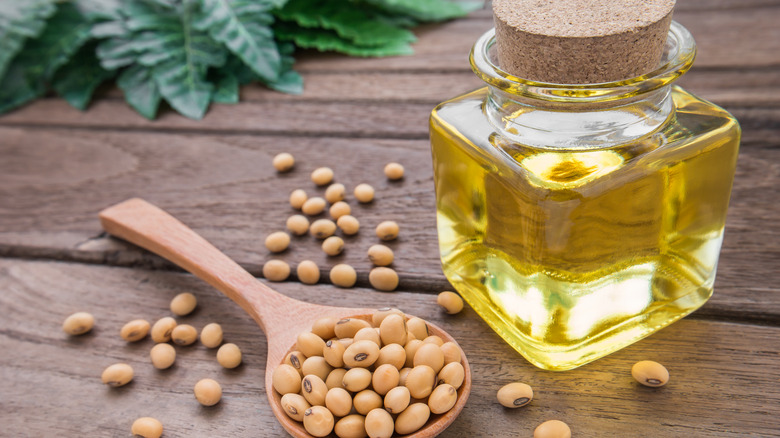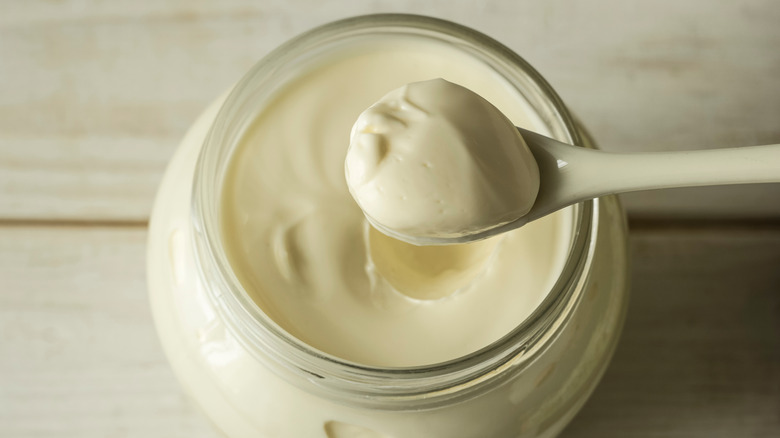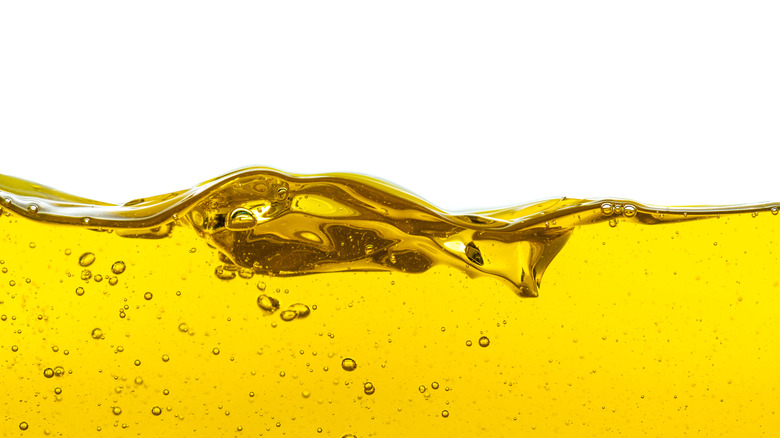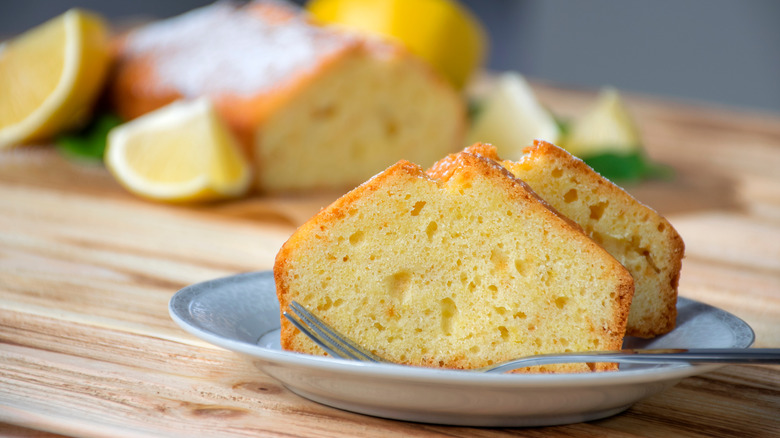What You Didn't Know About Organic Mayonnaise
It's hard to imagine a world without the popular condiment known as mayonnaise. Mayonnaise was, after all, the best-selling condiment in the U.S. in 2021, with sales reaching $164 million — an increase of 20 million since 2019 (via Statista.) Mayonnaise is the star ingredient in everything from tuna melt sandwiches and macaroni salad, to deviled eggs and artichoke spinach dip. Some like their mayonnaise to accompany their fries, and some prefer the likes of an aioli to really appeal to those taste buds.
However you prefer to eat your mayonnaise, you'll have two choices when perusing the grocery store: to buy or to not buy organic mayonnaise? That is the culinary question. Is there much of a difference between your standard and organically made options? What qualifies as organic these days anyway? If you've wondered about organic mayonnaise, deep in thought and late into the night (hey, so do we), then you've landed in the right place. Here's what you didn't know about organic mayonnaise.
Mayonnaise has been around since the 1700s (or earlier)
Though you may have never considered the age of mayonnaise, it made its debut during the 1700s. That's quite a long streak considering it's still standing strong today. While early versions were void of many ingredients used currently (along with preservatives), it had a long journey ahead until making it on everyone's favorite sandwich.
According to The Nibble, olive oil blended with eggs are believed to have been consumed by early Egyptians and Romans, but not the emulsion we see today. It's understood that the condiment, that's similar to as we know it now, was introduced to France in the mid-1700s from a city on Minorca (an island in the Mediterranean Sea off the coast of Spain) known as Mahón. This is how the condiment earned its name, written as "mahónnaise."
Although, traditionally thought of as a creation of French origin, we can see that is actually false, as it technically has Spanish origins. In fact, according to HiLoBrow, allioli (most notable as aioli today) was around in the first century C.E., and consisted of an oil, garlic and salt emulsion. You can probably see why most aioli now incorporate mayonnaise to help with the mixture's texture.
What qualifies as organic?
You're not alone if you aren't certain what fits under the "organic" umbrella these days. How can mayonnaise be organic if it isn't a single ingredient, but rather multiple ingredients combined together making up this fluffy condiment? In the case of Hellmann's Organic Mayonnaise, their label specifies that their product is "made with organic cage-free eggs" as seen on Hellman's website. According to the USDA, this specific label means a product is made with a minimum of 70% organically-produced ingredients. Ultimately, not every ingredient found in an organic mayonnaise product may be organic, unless the label reads "100% organic" (exempting salt and water), as explained via Mayo Clinic.
In the case of Hellmann's, however, there are six other organic ingredients making up this healthy alternative to their classic recipe, so it has permission to carry the "USDA Organic" label (via SmartLabel.) In terms of standards for livestock and poultry, which eggs fall under (a key ingredient in mayonnaise), there are certain conditions chickens must be raised under to provide organically-produced eggs. This includes ingesting 100% organic feed, not being treated with prohibited substances, and having year-round access to roaming outside (courtesy of the USDA.)
Organic and regular mayonnaise ingredients are not that different
Organic mayonnaise versus regular mayonnaise is still, well, mayonnaise. With the obvious difference being that one is produced with added health consciousness and one is not, the ingredients themselves aren't wildly unfamiliar from each other. In the case of your standard Hellmann's Real Mayonnaise, which is not organic, SmartLabel shows us that you'll still find whole eggs, egg yolks, soybean oil, water, vinegar, salt, lemon juice and natural flavors — all ingredients found in Hellmann's organic counterpart.
There are a few exceptions in ingredients, and one of them is added sweetener. While Hellmann's Real Mayonnaise contains plain sugar, it is replaced with dried cane sugar in the organic product. According to WebMD, cane sugar is not all that different from white granulated sugar. While white sugar either comes from sugarcane or sugar beets, cane sugar is made directly from sugar cane. Neither provide the body with vital minerals or vitamins, and are processed as simple carbohydrates. Both organic and regular mayonnaise of the Hellmann's brand specify these products aren't a significant source of total sugars or added sugars on their nutrition labels.
So, what's wrong with regular mayonnaise?
Thinking of dousing more than a serving's worth of mayonnaise on your turkey club sandwich or, better yet, a BLT? While there is nothing wrong with eating high-fat foods in moderation, and mayonnaise does contain some amount of healthy fats, you'll want to remain mindful if considering eating it everyday (unfair, we know.) So, what distinguishes organic mayonnaise from its regular counterpart? Aside from being produced organically, there's also one added ingredient in Hellmann's Real Mayonnaise that is absent in its organic version. Known as calcium disodium EDTA, it's a preservative meant to bind ingredients together and prevent loss of flavor, according to Healthline. An odorless crystalline powder also found in cosmetic products, this preservative isn't exactly healthy as it isn't easily digestible.
We learn through Health Digest that you could also be getting more nutrients by consuming alternatives to mayonnaise, like Greek yogurt, olive oil, or simply use mustard instead of mayonnaise. Additionally, making your own mayonnaise is always a way to ensure that you'll be able to control what goes into it. Rather than Hellmann's Real Mayonnaise's use of soybean oil, if making a homemade version, you can use flaxseed, sesame, olive, safflower, or avocado oils to boost your healthy fats intake (via Livestrong.)
Organic mayonnaise is still healthier
Organic mayonnaise still reigns higher on the health scale for a couple of reasons. Coming from ingredients that must undergo health guidelines is one factor, and nutritional value is another. The eggs used in organic mayonnaise, in the case of Hellmann's, bear not only an organic label, but also claim they're cage-free. According to the USDA, eggs with this label must pass a review process to ensure proper sanitation measures took place in their production, as well as refrigeration and overall quality. Free roaming and access to unlimited eating and hydration must be provided to hens if they are to produce cage-free eggs.
Organic mayonnaise and regular mayonnaise do have nutritional differences worth taking into account when you're considering which to select on your next grocery run. Aside from their similar ingredients, the nutritional value found in organic mayonnaise is greater. While there is 11 grams of fat in Hellmann's Organic Mayonnaise and 10 grams in its standard kind, the key lies in which type of fat. The organic mayonnaise contains a little under 10 grams of polyunsaturated and monounsaturated fats combined, while the standard has around 8. Often referred to as the "good fats," these types are healthier than saturated fats, as saturated ones can raise cholesterol levels (via Medical News Today.)
Organic mayonnaise's off taste can be explained
If you've experienced an extra acidic taste when eating organic mayonnaise, it turns out that's perfectly okay. There's a proper explanation as to why this might happen, and with differing taste buds, you might never experience this taste or notice it as any different than regular mayonnaise. However, if you do, it's due to the lack of preservatives found in organic mayonnaise, as explained by author Harold McGee (via Food52). McGee wrote, "Products that lack an antioxidant or preservative are likely to develop rancidity in the oil, and that can be metallic, fishy, painty, or stale-nut-like depending on the recipe." No added vitamin E will also contribute to the taste difference.
The dried cane syrup found in Hellmann's Organic Mayonnaise is most likely present to help balance out the vinegar's tart notes while hiding unusual flavors that occur with oxidation. Calcium disodium EDTA, an ingredient used in preserving non-organic mayonnaise, gives a salty flavor, according to Healthline. Considering it isn't found in Hellmann's Organic Mayonnaise, it could also contribute to the taste difference.
It lasts longer than you'd think
Mayonnaise, in general, has a longer shelf life than you might expect from an animal by-product. According to H-E-B, in the case of Hellmann's Organic Mayonnaise (and most mayonnaise you'll find for that matter), it's essential to keep it refrigerated after opening, preferably in the refrigerator door to maintain quality freshness. (Note: freezing mayonnaise is not advised.) So, how long can you keep your favorite condiment in the safety of your fridge before saying goodbye? Assuming you don't finish it all by the expiration date, your mayonnaise can last up to three to four weeks after the best before date, according to CBC News.
The USDA explains to us a misconception many of us have around mayonnaise in general: It is the culprit of food-borne illness when served in foods like chicken or tuna salad. Mayonnaise contains acidic ingredients (often lemon and vinegar), and these are actually known for preventing bacteria from forming in the mayonnaise. Typically, the meat or other sandwich contents are what bacteria clings to if left unrefrigerated for two hours or more.
It's alright if your mayonnaise splits under certain conditions
An alarm might go off in the food safety department of your brain when you open your jar of mayonnaise and it has totally separated. Have no fear (or, fear less), as it might still be safe to eat. According to Hunter & Gatherer, organic mayonnaise (such as their own) has reasons why it might be more susceptible to splitting than standard mayonnaise. Vinegar, easily absorbed by water and later dissolved, does not have the same properties as oil. Oil, known as a hydrophobic element, will float on water and reject absorption. This is how the two substances separate. Oils originating from avocados or olives, for instance, tend to solidify in cold temperatures (such as your fridge) and this can also cause separation.
However, always use your best judgment when it comes to food safety. According to Eating Expired, excess water gathered on top of mayonnaise while it is split most likely means it's ready to enter the next phase of its life: the garbage. Mold clinging to the neck of the jar is a sure sign it's meant for the trash too, and if an acidic or putrid smell accompanies it, don't hesitate to toss it. If it's split simply because the ingredients were not emulsified enough, mayonnaise can be brought back to life by adding boiling water and whisking the heck out of it.
Popular Hellmann's Organic Mayonnaise was introduced in 2016
The Hellmann's brand has wowed customers for a while with the quality of their products. The National Post reports that, in 2013, Americans spent $1.87 billion on mayonnaise, and Hellmann's Mayonnaise made up a 31.1% share of that amount. Hellmann's Real Mayonnaise ranks number one in popularity via Nutritionix. As for the organic version, one five-star customer review on Influenster reads, "The texture and creaminess stays like the original with the added knowledge that it's at least healthier for me." Hellmann's first released their organic mayonnaise brand in 2016, according to Unilever. Mass distributed across the U.S. due to popular demand, the brand's new version quickly gained popularity. Offered in three flavors, including Roasted Garlic and Spicy Chipotle, the brand still carries those today along with their classic version.
When Richard Hellmann, a German immigrant who owned a deli in New York began selling his own mayonnaise recipe made from raw egg yolks, vegetable oil, vinegar, salt and sugar, he sold it in jars perfectly sized to fit spoons for scooping (courtesy of Southern Living.) The famous blue ribbon look would start the Hellmann's brand on a good foot, later coming out with a cookbook that helped consumers learn how to incorporate the product in everyday recipes. Flash forward and Hellmann's Organic Mayonnaise is now carried by Unilever, a world-leading food supplier that also carries popular food brands like Ben and Jerry's Ice Cream, Country Crock, and Lipton, among many others.
It can be used to moisten baked goods
Yup, you read that right: organic mayonnaise is a great tool to help satiate your sweet tooth. Traditionally paired with savory foods, we're here to remind you that it's a great ingredient to moisten up baked goods, especially cakes, and give them that fluff factor. And you've got a couple options here. Either you can add mayonnaise to your cake mix to give it a homemade feel, or you can prepare a cake with it as a featured ingredient for more of an elevation.
Why does organic mayonnaise work so well to bring life to baked goods? According to How Stuff Works, the contents of organic mayonnaise can help a baked good attain just the right amount of moisture, thanks to the eggs and oils already found in the condiment. Due to the organically-produced ingredients in this version of the condiment, you'll be a little more on track with your health goals, too. You might consider replacing eggs with mayonnaise altogether, but that isn't advised, as different brands of organic mayonnaise contain varying amounts of egg. Not only can cakes benefit from a dollop of organic mayonnaise, but doughnuts will become softer in texture, pie crusts flakier, and just a bit will render your scrambled eggs velvety. A tangy flavor can be expected when adding a little bit of this condiment to a recipe.
It's a great cleaning agent, even for plants
Organic mayonnaise for house plants? Mayonnaise is not just for your stomach, it can also be a tool used for cleaning, including your house plants. As explained by ProFlowers, use a cloth or paper towel to gently apply mayonnaise to the leaves of your plant in order to remove dust and give them a shiny luster. It's especially effective for plants that produce sap or other sticky substances. Because of its organically-produced ingredients and lack of preservatives, you can rest assured it won't hurt your plants.
Besides using organic mayonnaise to achieve shiny leaves on our green friends, the condiment can also be used to remove grubbiness — such as sticker residue or pencil marks — off of walls, according to The Sun. Applying a spoonful of organic mayonnaise to a child's wall pencil sketch is a cinch and only needs to sit for a few minutes. Wiping off the organic mayonnaise with a warm cloth will result in the absence of the condiment, and with it, those very artful markings.
Water marks can also be removed from aging furniture, thanks to this creamy condiment. Using the back of a spoon is all you need to spread the organic mayonnaise onto a stubborn watermark, giving it five hours to do its magic (or waiting longer depending on the seriousness of the case), and finally wiping it off. Following this process up with a nice and easy wood polish will erase that watermark completely.
